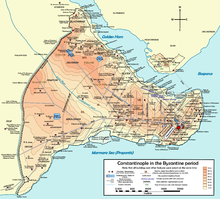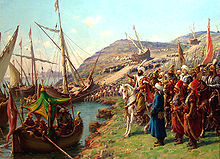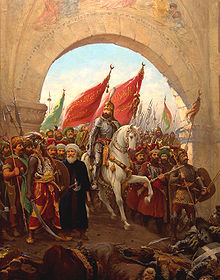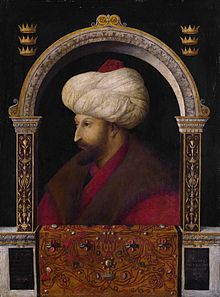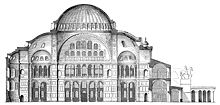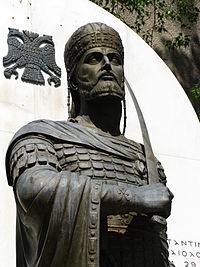- Fall of Constantinople
-
This article is about the 1453 siege. For earlier attacks on the city, see List of sieges of Constantinople.
Conquest of Constantinople Part of the Byzantine–Ottoman Wars and Ottoman wars in Europe 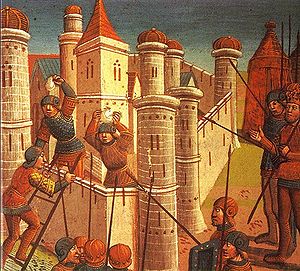
The Siege of Constantinople (painted 1499).Date April 6, 1453 – May 29, 1453 Location Constantinople (present-day Istanbul) Result Decisive Ottoman victory;[1][2][3]
End of the Byzantine Empire;
Constantinople made Ottoman capital;
Beginning of Christendom's modern ageBelligerents  Byzantine Empire
Byzantine Empire
 Republic of Genoa
Republic of Genoa Ottoman Empire
Ottoman EmpireCommanders and leaders  Constantine XI †
Constantine XI †
 Loukas Notaras
Loukas Notaras 
 Giovanni Giustiniani †[4]
Giovanni Giustiniani †[4] Mehmed II
Mehmed II
 Zagan Pasha
Zagan Pasha
 Suleiman Baltoghlu
Suleiman BaltoghluStrength 7,000[5]
26 ships[6]80,000[7][8][9](Based on recent estimates and Ottoman archival data) 160,000[10][11]-200,000[4] to 300,000[12] (Contemporanous Western estimates)
Casualties and losses 4,000 killed[15] Unknown - Bapheus
- Catalan Campaign
- Bursa
- Pelekanon
- Nicaea
- Nicomedia
- 1st Gallipoli
- Adrianople
- 2nd Gallipoli
- Philadelphia
- 1st Constantinople
- Thessalonica
- 2nd Constantinople
The Fall of Constantinople was the capture of the capital of the Byzantine Empire, which occurred after a siege by the Ottoman Empire, under the command of Ottoman Sultan Mehmed II, against the defending army commanded by Byzantine Emperor Constantine XI. The siege lasted from Friday, 6 April 1453 until Tuesday, 29 May 1453 (according to the Julian Calendar), when the city was conquered by the Ottomans.
The Fall of Constantinople marked the end of the final remnant of the Roman Empire, an empire which had lasted for nearly 1,500 years; it was also a massive blow to Christendom. After the conquest Mehmed made Constantinople the Ottoman Empire's new capital. Several Greek and non-Greek intellectuals fled the city before and after the siege, migrating particularly to Italy. It is argued that they helped fuel the Renaissance. Some mark the end of the Middle Ages by the fall of the city and empire.[16]
Contents
State of the Byzantine Empire
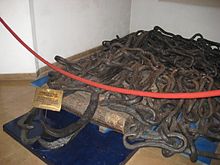 Constantine stretched this chain across the Golden Horn to prevent Mehmed's ships from entering into the city of Constantinople in 1453. Today it belongs to the Istanbul Military Museum.
Constantine stretched this chain across the Golden Horn to prevent Mehmed's ships from entering into the city of Constantinople in 1453. Today it belongs to the Istanbul Military Museum.
In the 1,123 years of the existence of the Byzantine Empire, Constantinople had been besieged many times but had been captured only once, during the Fourth Crusade in 1204.[17] The crusaders had most likely not intended to conquer Byzantium in the beginning, and an unstable Latin state was established in Constantinople. The Byzantine Empire fell apart into a number of Greek successor states, notably Nicaea, Epirus and Trebizond. The Greek states fought as allies against the Latin establishments but also as rivals against each other over the Byzantine throne. The Nicaean Greeks were the first to re-conquer Constantinople from the Latins in 1261. In the following two centuries, the much-weakened Byzantine Empire faced attacks from the Latins, the Serbians, the Bulgarians and most importantly, the Ottoman Turks.[7][18][19][20] The Black Plague between 1346 and 1349 killed almost half of Consantinople's inhabitants[citation needed]. By 1453 the empire was exhausted, consisting of a few square miles outside the city of Constantinople itself, the Princes' Islands in the Sea of Marmara, and the Peloponnese with its cultural center at Mystras. The Empire of Trebizond, a completely independent successor state that formed in the aftermath of the Fourth Crusade, also survived on the coast of the Black Sea.
Preparations
 The Dardanelles Gun, cast in 1464 and based on the Orban bombard from Hungary that was used for the Ottoman besiegers of Constantinople in 1453. Today it belongs to the British Royal Armouries collection.
The Dardanelles Gun, cast in 1464 and based on the Orban bombard from Hungary that was used for the Ottoman besiegers of Constantinople in 1453. Today it belongs to the British Royal Armouries collection.
When Sultan Murad II was succeeded by his son Mehmed II in early 1451, it was widely believed that the new young Sultan, who was then 19 years old, would be an incapable ruler and could pose no great threat to Christian possessions in the Balkans and the Aegean.[21] This belief was reinforced by Mehmed's friendly assurances to envoys who were sent to him at the beginning of his reign.[22] During the spring and summer of 1452, Mehmed II, whose great grandfather Bayezid I had previously built a fortress on the Asian side of the Bosphorus called Anadolu Hisarı, now built a second fortress several miles north of Constantinople on the European side, directly across the strait from Anadolu Hisarı, which would increase Turkish influence on the straits.[22] An especially relevant aspect of this fortress was its ability to prevent help from Genoese colonies on the Black Sea coast from reaching the city. This castle was called Rumeli Hisarı, Rumeli and Anadolu being the names of the European and Asian portions of the Ottoman Empire, respectively. The new fortress is also known as Boğazkesen, which has a dual meaning in Turkish: strait-blocker or throat-cutter, emphasizing its strategic position. The Greek name of the fortress, Laimokopia, also bears the same double meaning. In October 1452, Sultan Mehmed II ordered Turakhan Beg and his sons Ahmad and Omar to lead a large force to the Peloponnese and to remain there all winter in order to keep the despots Thomas and Demetrios from assisting their brother Constantine during the Siege of Constantinople.[23]
The Byzantine Emperor Constantine XI appealed to Western Europe for help, but his request did not meet with success. Ever since the mutual excommunication of the Orthodox and Roman Catholic Churches in 1054, the Roman Catholic West had been trying to gain dominion over the East; union had been attempted before at Lyon in 1274 and, indeed, some Paleologan emperors had since been received in the Latin Church. Emperor John VIII Palaiologos had attempted to negotiate Union with Pope Eugene IV, and the Council held in 1439 resulted in the proclamation, in Florence, of a Bull of Union. In the following years, a massive propaganda initiative was undertaken by anti-unionist forces in Constantinople and the population as well as the leadership of the Byzantine Church was in fact bitterly divided. Latent ethnic hatred between Greeks and Italians stemming from the events of 1204 and the sack of Constantinople by the Latins also played a significant role, Finally the Union failed, greatly annoying Pope Nicholas V and the Roman Catholic Church.
In the summer of 1452, when Rumeli Hisari was completed and the threat had become imminent, Constantine wrote to the Pope, promising to implement the Union, which was declared valid by a half-hearted imperial court on Tuesday 12 December 1452.[22] Although he was eager for an advantage, Pope Nicholas V did not have the influence the Byzantines thought he had over the Western Kings and Princes, some of whom were wary of increasing Papal control, and these had not the wherewithal to contribute to the effort, especially in light of the weakened state of France and England from the Hundred Years' War, Spain being in the final part of the Reconquista, the internecine fighting in the German Principalities, and Hungary and Poland's defeat at the Battle of Varna of 1444. Although some troops did arrive from the mercantile city states in the north of Italy, the Western contribution was not adequate to counterbalance Ottoman strength. Some Western individuals, however, came to help defend the city on their own account. One of these was an accomplished soldier from Genoa, Giovanni Giustiniani, who arrived with 700 armed men in January 1453.[24] A specialist in defending walled cities, he was immediately given the overall command of the defense of the land walls by the emperor. Around the same time, the captains of the Venetian ships which happened to be present in the Golden Horn offered their services to the Emperor, barring contrary orders from Venice, and Pope Nicholas undertook to send three ships laden with provisions, which set sail near the end of March.[25] In Venice, meanwhile, deliberations were taking place concerning the kind of assistance the Republic would lend to Constantinople. The Senate decided upon sending a fleet, but there were delays, and when it finally set out late in April, it was already too late for it to be able to partake in the battle.[26] Further undermining Byzantine morale, seven Italian ships with around 700 men slipped out of the capital at the moment when Giustiniani arrived, men who had sworn to defend the capital. At the same time, Constantine's attempts to appease the Sultan with gifts ended with the execution of the Emperor's ambassadors — even Byzantine diplomacy could not save the city.[22]
Fearing a possible naval attack along the shores of the Golden Horn, Emperor Constantine XI ordered that a chain be placed at the mouth of the harbour. This chain, which floated on wooden logs, was strong enough to prevent any Turkish ship from entering the harbour. This device was one of two which gave the Byzantines some hope of extending the siege until the possible arrival of foreign help.[27] This strategy was enforced because in 1204 the armies of the 4th Crusade successfully circumvented Constantinople's land defenses by breaching the Golden Horn Wall. Another strategy employed by the Byzantines was the repair and fortification of the Land Wall (Theodosian Walls). Emperor Constantine deemed it necessary to ensure that the Blachernae district's wall were the most fortified because that section of the wall protruded northwards. The Land Wall consisted of separate parallel walls dotted with towers every 50–60 yards and crenelations. In addition to the improvements made to the Theodosian Walls, the Byzantine defenders could rely on a 60 ft (18 m) wide moat that fronted the outermost portion of the fortifications.[28]
Strength
The army defending Constantinople was relatively small; it totalled about 7,000 men, 2,000 of whom were foreigners.[29] At the onset of the siege probably 50,000 people were living within the walls, including the refugees from the surrounding area.[30] Turkish commander Dorgano, who was in Constantinople in the pay of the Emperor, was also guarding one of the quarters of the city on the seaward side with the Turks in his pay.[31] These Turks kept loyal to the Emperor and perished in the ensuing battle.
The Ottomans, on the other hand, had a larger force. Recent studies and Ottoman archival data point out that there were about 80,000 Ottoman soldiers including 5/6,000–10,000 elite Janissaries [4][8][9] and thousands of Christian troops,[31] notably 1,500 Serbian cavalry that the Serbian lord Đurađ Branković supplied as part of his obligation to the Ottoman sultan. But just a few months before, he had supplied the money for the reconstruction of the walls of Constantinople. Contemporaneous Western witnesses of the siege, who tend to exaggerate the military power of the Sultan, provide disparate and higher numbers ranging from 160,000 to 200,000 and to 300,000[4] (Niccolò Barbaro: 160,000;[32] the Florentine merchant Jacopo Tedaldi[33] and the Great Logothete George Sphrantzes:[10] 200,000; the Cardinal Isidore of Kiev[34] and the Archbishop of Mytilene Leonardo di Chio:[35] 300,000).[36]
Ottoman dispositions and strategies
Mehmed built a fleet to besiege the city from the sea (partially manned by Greek sailors from Gallipoli).[8] Contemporary estimates of the strength of the Ottoman fleet span between about 100 ships (Tedaldi),[33] 145 (Barbaro),[32] 160 (Ubertino Pusculo),[37] 200–250 (Isidore of Kiev,[34] Leonardo di Chio)[38] to 430 (Sphrantzes).[10] A more realistic modern estimate predicts a fleet strength of 126 ships, specifically composed of 6 large galleys, 10 ordinary galleys, 15 smaller galleys, 75 large rowing boats, and 20 horse-transports.[13]
Before the siege of Constantinople, it was known that the Ottomans had the ability to cast medium-sized cannons, but the range of some pieces they were able to field far surpassed the defenders' expectations. Instrumental to this Ottoman advancement in arms production was a somewhat mysterious figure by the name of Orban (Urban), a Hungarian (though some suggest he was German).[39] One cannon designed by Orban was named "Basilica" and was 27 feet (8.2 m) long, and able to hurl a 600 lb (272 kg) stone ball over a mile (1.6 km).[40]
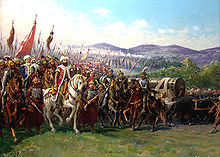 Modern painting of Mehmed II and the Ottoman Army approaching Constantinople, transporting a giant bombard by Fausto Zonaro (1854–1929).
Modern painting of Mehmed II and the Ottoman Army approaching Constantinople, transporting a giant bombard by Fausto Zonaro (1854–1929).
The master founder initially tried to sell his services to the Byzantines, who were unable to secure the funds needed to hire him. Orban then left Constantinople and approached Mehmed II, claiming that his weapon could blast 'the walls of Babylon itself'. Given abundant funds and materials, the Hungarian engineer built the gun within three months at Adrianople, from which it was dragged by sixty oxen to Constantinople. In the meantime, Orban also produced other cannons instrumental for the Turkish siege forces.[41]
Orban's cannon had several drawbacks however: it took three hours to reload; cannon balls were in very short supply; and the cannon is said to have collapsed under its own recoil after six weeks (this fact however is disputed,[4] being reported only in the letter of Archbishop Leonardo di Chio[35] and in the later and often unreliable Russian chronicle of Nestor Iskander).[42] Having previously established a large foundry about 150 miles (240 km) away, Mehmed now had to undergo the painstaking process of transporting his massive artillery pieces. Orban's giant cannon was said to have been accompanied by a crew of 60 oxen and over 400 men.[39]
Mehmed planned to attack the Theodosian Walls, the intricate series of walls and ditches protecting Constantinople from an attack from the West, the only part of the city not surrounded by water. His army encamped outside the city on the Monday after Easter, 2 April 1453.
The bulk of the Ottoman army were encamped south of the Golden Horn. The regular European troops, stretched out along the entire length of the walls, were commanded by Karadja Pasha. The regular troops from Anatolia under Ishak Pasha were stationed south of the Lycus down to the Sea of Marmara. Mehmed himself erected his red-and-gold tent near the Mesoteichion, where the guns and the elite regiments, the Janissaries, were positioned. The Bashi-bazouks were spread out behind the front lines. Other troops under Zagan Pasha were employed north of the Golden Horn. Communication was maintained by a road that had been constructed over the marshy head of the Horn.[43]
Byzantine dispositions and strategies
The city had about 20 km of walls (Theodosian Walls: 5.5 km; sea walls along the Golden Horn: 7 km; sea walls along the Sea of Marmara: 7.5 km), one of the strongest sets of fortified walls in existence at the time. The walls had recently been repaired (under John VIII) and were in fairly good shape, giving the defenders sufficient reason to believe that they could hold out until help from the West arrived.[44] In addition, the defenders were relatively well-equipped with a fleet of 26 ships: 5 from Genoa, 5 from Venice, 3 from Venetian Crete, 1 from Ancona, 1 from Aragon, 1 from France, and about 10 Byzantine.[6]
On April 5, as the Sultan himself arrived with his last troops, the defenders took up their positions.[45] As their numbers were insufficient to occupy the walls in their entirety, it had been decided that only the outer walls would be manned. Constantine and his Greek troops guarded the Mesoteichion, the middle section of the land walls, where they were crossed by the river Lycus. This section was considered the weakest spot in the walls and an attack was feared here most. Giustiniani was stationed to the north of the emperor, at the Charisian Gate (Myriandrion); later during the siege, he was shifted to the Mesoteichion to join Constantine, leaving the Myriandrion to the charge of the Bocchiardi brothers. Minotto and his Venetians were stationed in the Blachernae palace, together with Teodoro Caristo, the Langasco brothers, and Archbishop Leonardo of Chios. To the left of the emperor, further south, were the commanders Cataneo, with Genoese troops, and Theophilus Palaeologus, who guarded the Pegae Gate with Greek soldiers. The section of the land walls from the Pegae Gate to the Golden Gate (itself guarded by a certain Genoese called Manuel) was defended by the Venetian Filippo Contarini, while Demetrius Cantacuzenus had taken position on the southernmost part of the Theodosian wall. The sea walls were manned more sparsely, with Jacobo Contarini at Stoudion, a makeshift defense force of Greek monks to his left hand, and prince Orhan at the Harbour of Eleutherius. Péré Julia was stationed at the Great Palace with Genoese troops; Cardinal Isidore of Kiev guarded the tip of the peninsula near the boom. The sea walls at the southern shore of the Golden Horn were defended by Venetian and Genoese sailors under Gabriele Trevisano. Two tactical reserves were kept behind in the city, one in the Petra district just behind the land walls and one near the Church of the Holy Apostles, under the command of Loukas Notaras and Nicephorus Palaeologus, respectively. The Venetian Alviso Diedo commanded the ships in the harbor. Although the Byzantines also had cannons, they were much smaller than those of the Ottomans and the recoil tended to damage their own walls.[35]
According to David Nicolle (2000), despite many odds, the idea that Constantinople was inevitably doomed is wrong, and the overall situation was not as one-sided as a simple glance at a map might suggest.[46] It has also been claimed that Constantinople was "the best-defended city in Europe" at that time.[47]
Siege of the city
At the beginning of the siege, Mehmed sent out some of his best troops to reduce the remaining Byzantine strongholds outside the city of Constantinople. The fortress of Therapia on the Bosphorus and a smaller castle at the village of Studius near the Sea of Marmara were taken within a few days. The Princes' Islands in the Sea of Marmara were taken by Admiral Baltoghlu's fleet.[48]
Mehmed's massive cannon fired on the walls for weeks, but due to its imprecision and extremely slow rate of reloading the Byzantines were able to repair most of the damage after each shot, limiting the cannon's effect.[49]
Meanwhile, despite some probing attacks, the Ottoman fleet under Suleiman Baltoghlu could not enter the Golden Horn due to the chain the Byzantines had laid across the entrance, and although one of its main tasks was to prevent any ships from outside from entering the Golden Horn, on 20 April a small flotilla of four Christian ships[50] managed to slip in after some heavy fighting, an event which strengthened the morale of the defenders and caused embarrassment to the Sultan.[49] Baltoghlu's life was spared after his subordinates testified to Mehmed of his brave, yet fruitless efforts during the conflict.[awkward]
The following day, on the 21st of May, the sultan sent an ambassador to Constantinople. He asked for the surrender of the city, on the promise he would allow the Emperor and any other inhabitant to leave with their posessions. Moreover, he would recognise the Emperor as governor of the Peloponese. Lastly, he guaranteed the safety of the population that would remain in the city. The counter-proposals of Constantine XI were characterised by dignity and decisiveness. He accepted to pay higher tribute to the sultan as well as the remainance of all the conquered castles and lands in the hands of the Turks.[51] Regarding, however, Constantinople, he stated:
" Giving you though the city depends neither on me nor on anyone else among its inhabitants; as we have all decided to die with our own free will and we shall not consider our lives. "[52]
After that, Mehmed tried to circumvent the chain. He ordered the construction of a road of greased logs across Galata on the north side of the Golden Horn, and rolled his ships across on 22 April.[49] This seriously threatened the flow of supplies from Genovese ships from the — nominally neutral — colony of Pera, and demoralized the Byzantine defenders. On the night of 28 April, an attempt was made to destroy the Ottoman ships already in the Golden Horn using fire ships, but the Ottomans had been warned in advance and forced the Christians to retreat with heavy losses. From then on, the defenders were forced to disperse part of their forces to the Golden Horn walls, causing defense in other sections of the walls to weaken.
The Turks had made several frontal assaults on the land wall, but were always repelled with heavy losses. Venetian surgeon Nicolò Barbaro, describing in his diary one of such frequent land attacks especially by the Jannisaries, wrote that:
They found the Turks coming right up under the walls and seeking battle, particularly the janissaries...and when one or two of them were killed, at once more Turks came and took away the dead ones...without caring how near they came to the city walls. Our men shot at them with guns and crossbows, aiming at the Turk who was carrying away his dead countryman, and both of them would fall to the ground dead, and then there came other Turks and took them away, none fearing death, but being willing to let ten of themselves be killed rather than suffer the shame of leaving a single Turkish corpse by the walls.[31]
After these inconclusive frontal offensives, the Ottomans sought to break through the walls by constructing underground tunnels in an effort to mine them from mid-May to 25 May. Many of the sappers were miners of German origin sent from Novo Brdo by the Serbian Despot. They were placed under the command of Zagan Pasha. However, the Byzantines employed an engineer named Johannes Grant (who was said to be German but was probably Scottish), who had counter-mines dug, allowing Byzantine troops to enter the mines and kill the Turkish workers. The Byzantines intercepted the first Serbian tunnel on the night of 16 May. Subsequent tunneling efforts were interrupted on 21, 23, and 25 May, destroying them with Greek fire and vigorous combat. On 23 May, the Byzantines captured and tortured two Turkish officers, who revealed the location of all the Turkish tunnels, which were then destroyed.[53]
Mehmed offered to lift the siege if they gave him the city, but this offer was declined. Around this time, Mehmed had a final council with his senior officers. Here he encountered some resistance; one of his Viziers, the veteran Halil Pasha, who had always disapproved of Mehmed's plans to conquer the city, now admonished him to abandon the siege in the face of recent adversity. Halil was overruled by Zagan Pasha, who insisted on an immediate attack. Having been accused of bribery, Halil Pasha was put to death later that year.[54] Mehmed planned to overpower the walls by sheer force, expecting that the weakened Byzantine defense by the prolonged siege would now be worn out before he ran out of troops and started preparations for a final all-out offensive.
Final assault
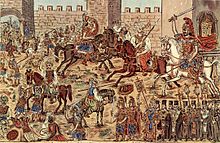 Painting by the Greek folk painter Theophilos Hatzimihail showing the battle inside the city, Constantine is visible on a white horse
Painting by the Greek folk painter Theophilos Hatzimihail showing the battle inside the city, Constantine is visible on a white horse
Preparations for the final assault were started in the evening of May 26 and continued to the next day.[55] For 36 hours after the war council decision to attack the Ottomans extensively mobilized their manpower in order to prepare for the general offensive.[55] Prayer and resting would be then granted to the soldiers on the 28th, and then the final assault would be launched. On the Byzantine side, a small Venetian fleet of 12 ships, after having searched the Aegean, reached the Capital on May 27 and reported to the Emperor that no large Venetian relief fleet was on its way.[56] On May 28, as the Ottoman army prepared for the final assault, large-scale religious processions were held in the city. In the evening a last solemn ceremony was held in the Hagia Sophia, in which the Emperor and representatives of both the Latin and Greek church partook, together with nobility from both sides.[57]
Shortly after midnight on May 29 the all-out offensive began. First attacked the Christian troops of the Ottoman Empire,[31] followed by the successive waves of the irregular azaps, who were poorly trained and equipped, and Anatolians who focused on a section of the Blachernae walls in the northwest part of the city, which had been partially damaged by the cannon. This section of the walls had been built earlier, in the eleventh century, and was much weaker. Anatolians managed to breach this section of walls and entered the city but were just as quickly pushed back by the defenders. Finally, as the battle was continuing, the last wave, consisting of elite Jannissaries, attacked the city walls. The Genoese general in charge of the land troops,[4][34][35] Giovanni Giustiniani, was grievously wounded during the attack, and his evacuation from the ramparts caused a panic in the ranks of the defenders.[58] Giustiniani was carried to Chios, where he succumbed to his wounds a few days later.
With Giustiniani’s Genoese troops retreating into the city and towards the harbor, Constantine and his men, now left to their own devices, kept fighting and managed to hold off the Jannisaries for a while, but eventually they could not stop them from entering the city. The defenders were also being overwhelmed at several points in Constantine’s section. When Turkish flags were seen flying above a small postern gate, the Kerkaporta, which was left open, panic ensued, and the defense collapsed, as Janissary soldiers, led by Ulubatlı Hasan pressed forward. It is said that Constantine, throwing aside his purple regalia, led the final charge against the incoming Ottomans, dying in the ensuing battle in the streets like his soldiers. On the other hand Nicolò Barbaro, a Venetian eyewitness to the siege, wrote in his diary that it was said that Constantine hanged himself at the moment when the Turks broke in at the San Romano gate,[31] although his ultimate fate remains unknown.[59]
After the initial assault, the Ottoman Army fanned out along the main thoroughfare of the city, the Mese, past the great forums, and past the Church of the Holy Apostles, which Mehmed II wanted to provide a seat for his newly appointed patriarch which would help him better control his Christian subjects. Mehmed II had sent an advance guard to protect key buildings such as the Holy Apostles, as he did not wish to establish his new capital in a thoroughly devastated city.
The Army converged upon the Augusteum, the vast square that fronted the great church of Hagia Sophia whose bronze gates were barred by a huge throng of civilians inside the building, hoping for divine protection. After the doors were breached, the troops separated the congregation according to what price they might bring in the slave markets. Mehmed II allowed his troops to plunder the city for three days.[60] Soldiers fought over the possession of some of the spoils of war.[61] According to the Venetian surgeon Nicolò Barbaro "all through the day the Turks made a great slaughter of Christians through the city".[62] However, according to British historian David Nicolle, the citizens of Constantinople were treated better by their Ottoman Conquerors than their ancestors had been by the Crusaders in 1204; only about 4,000 Greeks died in the siege.[63] On the third day of the conquest, Mehmed II ordered all looting to stop and sent his troops back outside the city walls.[63]
Ottoman casualties
Ottoman casualties are unknown but they are believed by most historians to be very heavy due to several unsuccessful Ottoman attacks made during the siege and final assault. The Venetian surgeon Barbaro describes the sea around the capital floating with the bodies of the Turks and Christians "like melons out to canal". Whatever the Ottoman casualties, the Empire had to recover its strength for its invasion of Christian Europe. To the East lay the strong Turkish Karamanid principality , and to the North the Hungarians and numerous smaller states, such as the Despotate of Morea and the many Slavic territories in the Balkans contested by Hungary.
Aftermath
Byzantine historian George Sphrantzes was an eyewitness to the fall of Constantinople. In his chronicle about the fall of the city, he wrote down the events that had taken place at the end of the third day of the conquest:[64][65]
On the third day after the fall of our city, the Sultan celebrated his victory with a great, joyful triumph. He issued a proclamation: the citizens of all ages who had managed to escape detection were to leave their hiding places throughout the city and come out into the open, as they were remain free and no question would be asked. He further declared the restoration of houses and property to those who had abandoned our city before the siege, if they returned home, they would be treated according to their rank and religion, as if nothing had changed.—George SphrantzesThe loss of the city was a massive blow to Christendom. Pope Nicholas V called for an immediate counter-attack in the form of a crusade, but when no European monarch was willing to lead the crusade, the Pope himself decided to go but his early death eliminated the possibility of a counter-attack.
With Constantinople beneath his belt, Mehmed II had acquired a great, rich city albeit one in decline due to years of war. The Capital allowed the Turks to establish a permanent supply base in Europe. Further advances into the Kingdom of Hungary and the bordering states would have been difficult, if not impossible, without the harbors of Constantinople bringing in supplies and serving as a fortified center from which to administer the empire.
Far from being in its heyday, by then, Constantinople was severely depopulated as a result of the general economic and territorial decline of the empire following its partial recovery from the disaster of the Fourth Crusade inflicted on it by the Christian army two centuries before. Therefore, the city in 1453 was a series of walled villages separated by vast fields encircled by the fifth-century Theodosian walls. When the Ottoman troops first broke through the defenses, many of the leading citizens of these little townlets submitted their surrender to Mehmed's generals.[66] These villages, specifically along the land walls, were allowed to keep their citizens and churches and were protected by Mehmed's special contingents of Janissaries. It was these people who formed what the Ottomans called a Millet, a self-governing community in the multi-national Ottoman Empire of which Constantinople was to become the capital. Hagia Sophia was converted into a mosque, although the Greek Orthodox Church remained intact, and Gennadius Scholarius was appointed Patriarch of Constantinople.
Many Greeks, such as John Argyropoulos and Constantine Lascaris, fled the city and found refuge in the Latin West, bringing with them knowledge and documents from the Greco-Roman tradition to Italy and other regions that further propelled the Renaissance,[67][68] although the influx of Greek scholars into the West began much earlier, especially in the Northern Italian city-states which had started welcoming scholars in the eleventh and twelfth centuries.[citation needed] The chancellor of Florence Coluccio Salutati began this cultural exchange in 1396 by inviting Manuel Chrysoloras, a Byzantine scholar to lecture at the University of Florence.[69] The Italians' hunger for Latin classics and a reintroduction of the Greek language was a major intellectual factor underlying the Renaissance.[dubious ] Those Greeks who stayed behind in Constantinople mostly lived in the Phanar and Galata districts of the city. The Phanariotes, as they were called, provided many capable advisers to the Ottoman rulers.
The Morean (Peloponnesian) fortress of Mystras, where Constantine's brothers Thomas and Demetrius ruled, constantly in conflict with each other and knowing that Mehmed would eventually invade them as well, held out until 1460. Long before the fall of Constantinople, Demetrius had fought for the throne with Thomas, Constantine, and their other brothers John and Theodore.[70] Thomas escaped to Rome when the Ottomans invaded Morea while Demetrius expected to rule a puppet state, but instead was imprisoned and remained there for the rest of his life. In Rome, Thomas and his family received some monetary support from the Pope and other Western rulers as Byzantine emperor in exile, until 1503. In 1461 the independent Byzantine state in Trebizond fell to Mehmed.[70]
Scholars consider the Fall of Constantinople as a key event ending the Middle Ages and starting the Renaissance because of the end of the old religious order in Europe and the use of cannon and gunpowder. The fall of Constantinople and general encroachment of the Turks in that region also severed the main overland trade link between Europe and Asia, and as a result more Europeans began to seriously consider the possibility of reaching Asia by sea.[71]
Third Rome
With Byzantium considered the continuation of the Roman Empire, or the "Second Rome", the fall of Constantinople led competing factions to lay claim to being the "Third Rome". Russian claims to Byzantine heritage clashed with those of the Ottoman empire's own claim. In Mehmed's view, he was the successor to the Roman Emperor, declaring himself Kayser-i Rum, literally "Caesar of Rome", that is, of the Roman Empire, though he was remembered as "the Conqueror", founder of a political system that survived until 1922 with the establishment of the Republic of Turkey that has since held Constantinople (renamed Istanbul) but moved the capital of the Turkish state to Ankara. Such conflict in ideology only stimulated warfare between the Russian and Ottoman Empire, with the 18th and 19th century seeing Russian armies approach slowly closer to Constantinople. In fact the Russian armies came all the way to Yeşilköy suburb of Constantinople, which is only 10 miles (16 km) west of Topkapı Palace during the Russo-Turkish War of 1877–1878.
Stefan Dušan, Tsar of Serbia, and Ivan Alexander, Tsar of Bulgaria both made similar claims, regarding themselves as legitimate heirs to the Byzantine Empire. Other potential claimants, such as the Republic of Venice and the Holy Roman Empire have disintegrated into history. The Vatican is the final remaining claimant. Their claim dates back from the establishment of the Papal States which were originally forged as the "Rome-Ravenna" corridor after Emperor Justinian's conquests. Later placed under Frankish protection, the Papal States remained as they were throughout the centuries, until the 1870 conquest by Victor Emmanuel. It was not until the subsequent Lateran Treaty in 1929, that their claim to the Eastern Roman (Byzantine) Empire (330AD-1453AD) was revived, a continuous claim dating back over 1500 years.
In addition to the military and political benefits bestowed upon the Turks with its capture, it also brought the trade in Eastern Spices through Muslim intermediaries into a declining period. Europeans would continue to trade through Constantinople into the 16th century but high prices propelled the search for alternative sources of supply that did not pass through the intermediaries of the Ottomans and, to a lesser extent, the Safavids and Mamelukes. An increasing number of Portuguese, Spanish and Dutch ships began to attempt to sail to India via the southern tip of Africa. Indeed, had Columbus not believed that he would reach Asia to negotiate trade rights by sailing west—the mission as he presented it to his patron, the King of Spain—he would not have found the New World.
Cultural references
Legends
There are many legends in Greece surrounding the Fall of Constantinople. It was said that the total lunar eclipse that occurred on May 22, 1453, represented a fulfillment of a prophecy of the city's demise.[72] Four days later, the whole city was blotted out by a thick fog, a condition unknown in that part of the world in May. When the fog lifted that evening, a strange light was seen playing about the dome of the Hagia Sophia, and from the city walls lights were seen in the countryside to the West, far behind the Turkish camp. The light around the dome was interpreted by some as the Holy Spirit departing from the Cathedral, while there was a distant hope that the lights were the campfires of the troops of John Hunyadi who had come to relieve the city.[73] A more scientific theory postulates that the light was caused by the electrical weather phenomenon, St. Elmo's Fire.
Another of them holds that two priests saying divine liturgy over the crowd disappeared into the cathedral's walls as the first Turkish soldiers entered. According to the legend, the priests will appear again on the day Constantinople returns to Christian hands.[74] Another legend refers to the Marble King, Constantine XI, holding that, when the Ottomans entered the city, an angel rescued the emperor, turned him into marble and placed him in a cave under the earth near the Golden Gate, where he waits to be brought to life again (a variant of the sleeping hero legend).[75][76]
Cultural impact
The Christian re-conquest of Constantinople remained a fascinating and much sought-after event in Western Europe for years to come after its fall to the House of Osman. Rumours of Constantine XI's survival and subsequent rescue by an angel led many to hope that the city would one day return to Christian hands. However, as Western Europe entered the 15th century, the age of Crusading began to come to an end.
Initially, the fall of the city seemed to cause a stir of crusading zeal in the West, where, apart from religious sentiments, Renaissance humanism had for about a century been fueling an interest in the cultural and intellectual heritage of classical antiquity, and the role that Byzantium had played in preserving that heritage.
The great humanist Aeneas Silvius lamented that with the fall of Constantinople "Homer and Plato have died a second death". This utterance was not true for learning in the fallen city. In addition to this, refugees from Constantinople to Italy brought with them ancient texts that further inspired humanist investigation of ancient philosophy and esotericism, especially Platonic and Neo-Platonic thought.
As Pope Pius II, the same Aeneas Silvius declared a crusade in 1459 for the recapture of Constantinople, but any genuine enthusiasm that existed was short-lived, and a crusade never came into effect.
Guillaume Dufay composed several songs lamenting the fall of the Eastern church, and the duke of Burgundy, Philip the Good, avowed to take up arms against the Turks. However, as the growing Ottoman power from this date on coincided with the Protestant Reformation and subsequent Counter-Reformation, the recapture of Constantinople became an ever-distant dream. Even France, once a fervent participant of the Crusades, became an ally of the Ottomans.
Nonetheless, depictions of Christian coalitions taking the city and of the late Emperor's resurrection by Leo the Wise persisted.[77]
In 17th Century Russia, the Fall of Constantinople had a role in the fierce theological and political controversy between adherents and opponents of the reforms in the Russian Orthodox Church, carried out by Patriarch Nikon and intended to bring the Russian Church closer to the norms and practices of other Orthodox churches. Avvakum and other of the "Old Believers" saw these reforms as a corruption of the Russian Church, which they considered to be the "true" Church of God. As the other Churches were more closely related to Constantinople in their liturgies, Avvakum argued that Constantinople fell to the Turks because of these heretical beliefs and practices.
Avvakum Petrov (Russian: Аввакум Петров) (November 20, 1620 or 1621 – April 14, 1682) was a Russian protopope of Kazan Cathedral on Red Square who led the opposition to 's . His autobiography and letters to the tsar, Boyarynya Morozova and other Old Believers are considered masterpieces of 17th-century Russian literature.
Starting in 1652 Nikon, as Patriarch of the Russian Church, . These reforms were mostly intended to bring the Russian Church into line with the other Orthodox Churches of Eastern Europe and Middle East.
Greek armies invaded Turkey during the Greco-Turkish War of 1919–1922 after the defeat of the Ottoman Empire in the First World War, and planned occupying Constantinople but were beaten and unsuccessful in taking the city. After the Turkish War of Independence, Turkey emerged as a secular constitutional republic in 1923, later becoming a secular democratic republic in 1950 and joined NATO along with Greece in 1952.
Renaming of the city
It is widely believed that the city was renamed to "Istanbul" in the aftermath of the conquest. In actuality, Ottomans used the Arabic transliteration of the city's name, "Kostantiniyye," as can be seen in numerous Ottoman documents. The name of Istanbul, deriving from a Greek phrase ("to the City", Greek: eis -tin- polin) was probably already spread among the Turkish populace of the Ottoman Empire before the conquest.[citation needed] Istanbul would become the official name of the city in 1930 by the Turkish Postal Law of 1930 as part of Atatürk's reforms.[78][79][80]
In historical fiction
- Lew Wallace, The Prince of India; or, Why Constantinople Fell. New York: Harper & Brothers Publishers), 1893. 2 volumes
- Mika Waltari, The Dark Angel (Waltari) (Original title Johannes Angelos) 1952. Translated from the Finnish by Naomi Walford and pub. in English edition, New York: Putnam, 1953
- Jack Hight, Siege. London: John Murray Publisher Ltd, 2010
- C.C Humphreys, A Place called Armageddon. London: Orion, 2011
See also
- Byzantine Empire
- Constantine XI
- Janissary
- May 1453 lunar eclipse
- Mehmed II
- Military of the Ottoman Empire
- Orban
- Ottoman Empire
- Ulubatlı Hasan
Notes
- ^ [1][dead link]
- ^ Constantine XI (1449–1453) and the capture of Constantinople
- ^ oikoumene.org
- ^ a b c d e f Pertusi, Agostino, ed. (1976). La Caduta di Costantinopoli. Fondazione Lorenzo Valla: Verona. (An anthology of contemporary texts and documents on the fall of Constantinople; includes bibliographies and a detailed scholarly comment).
- ^ Runciman, Steven (1965). The Fall of Constantinople, 1453. Cambridge: Cambridge University Press. p. 85. ISBN 0-5213-9832-0.
- ^ a b Nicolle, David (2000). Constantinople 1453: The end of Byzantium. Oxford: Osprey Publishing. p. 45. ISBN 1841760919.
- ^ a b Norwich, John Julius (1997). A Short History of Byzantium. New York: Vintage Books.
- ^ a b c Nicolle 2000.
- ^ a b İnalcık, Halil (2008), Osmanlı İmparatorluğu Klasik Çağ (1300–1600)
- ^ a b c Chronicles of George Sphrantzes; Greek text is reported in A. Mai, Classicorum auctorum e Vaticanis codicibus editorum, tome IX, Romae 1837, pp 1–100
- ^ The Destruction of the Greek Empire, Edwin Pears
- ^ Leonardo di Chio, Letter,927B: "three hundred thousand and more".
- ^ a b Nicolle 2000, p. 44.
- ^ Uyar, Mesut; Erickson, Edward J. (2009). A military history of the Ottomans: from Osman to Atatürk. Santa Barbara: Praeger. p. 37. ISBN 9780275988760.
- ^ Phrantzes, The Fall of the Byzantine Empire
- ^ Crowley, Roger (2006). Constantinople: The Last Great Siege, 1453. Faber. ISBN 0-571-22185-8. (reviewed by Foster, Charles (September 22, 2006). "The fall of Constantinople and the end of empire". Contemporary Review. http://www.encyclopedia.com/doc/1G1-155920054.html. "Some say the Middle Ages ended then")
- ^ Norwich, John Julius (1997). A Short History of Byzantium. New York: Vintage Books. p. 304.
- ^ Madden, Thomas (2005). Crusades: The Illustrated History. Ann Arbor: University of Michigan.
- ^ Haldon, John (2000). Byzantium at War 600 - 1453. New York: Osprey.
- ^ Mango, Cyril (2002). The Oxford History of Byzantium. New York: Oxford UP.
- ^ Runciman 1965, p. 60
- ^ a b c d Norwich, John Julius (1997). A Short History of Byzantium. New York: Vintage Books. p. 373.
- ^ Setton, Kenneth M. (1978), The Papacy and the Levant (1204–1571), Volume II: The Fifteenth Century, DIANE Publishing, p. 146, ISBN 0-87169-127-2, "While Mehmed II had been making preparations for the siege of Constantinople, he had sent the old general Turakhan and the letter's two sons, Ahmed Beg and Omar Beg to invade the Morea and to remain there all winter to prevent the despots Thomas and Demetrius from coming to assistance to their brother Constantine XI"
- ^ Runciman 1965, pp. 83–84
- ^ Runciman 1965, p. 81
- ^ Runciman 1965, p. 85.
- ^ Donald M. Nicol, The Last Centuries of Byzantium: 1261–1453 (Cambridge University Press, 1993) p.380.
- ^ Michael Spilling, ed., Battles That Changed History: Key Battles That Decided the Fate of Nations ( London, Amber Books Ltd. 2010) p.187.
- ^ According to Phrantzes, whom Constantine had ordered to make a census, the Emperor was appalled when the number of native men capable of bearing arms turned out to be only 4,983. Leonardo di Chio gave a number of 6,000 Greeks. See Runciman 1965, p. 85.
- ^ Nicolle. Constantinople 1453, p. 32.
- ^ a b c d e deremilitari.org
- ^ a b Nicolò Barbaro, Giornale dell'Assedio di Costantinopoli, 1453. The autograph copy is conserved in the Biblioteca Marciana in Venice. Barbaro's diary has been translated into English by John Melville-Jones (New York:Exposition Press, 1969), part of which is available on deremilitare.org
- ^ a b (French) Concasty, M.-L., Les «Informations» de Jacques Tedaldi sur le siège et la prise de Constantinople
- ^ a b c (Latin) Epistola reverendissimi patris domini Isidori cardinalis Ruteni scripta ad reverendissimum dominum Bisarionem episcopum Tusculanum ac cardinalem Nicenum Bononiaeque legatum (letter of Cardinal Isidore to Cardinal Basilios Bessarion), dated 6 July 1453
- ^ a b c d (Latin) Leonardo di Chio, Letter to Pope Nicholas V, dated 16 August 1453, edited by J.-P. Migne, Patrologia Graeca, 159, 923A–944B.
- ^ Leonardo di Chio, Letter, 927B: "three hundred thousand and more".
- ^ Ubertino Pusculo, Constantinopolis, 1464
- ^ Leonardo di Chio, Letter, 930C.
- ^ a b Norwich, John Julius (1997). A Short History of Byzantium. New York: Vintage Books. p. 374.
- ^ Davis, Paul (1999). 100 Decisive Battles. Oxford. pp. 166. ISBN 978-0-19-514366-9.
- ^ Runciman 1965, pp. 77–78
- ^ Another expert who was employed by the Ottomans was Ciriaco de' Pizzicolli, also known as Ciriaco of Ancona, a traveler and collector of antiquities.
- ^ Runciman 1965, pp. 94–95.
- ^ Nicolle 2000, p. 39.
- ^ The following information is taken from Runciman (1965), pp. 92–94.
- ^ Nicolle 2000, p. 40.
- ^ "The fall of Constantinople". The Economist. 23 December 1999. http://www.economist.com/node/346800?story_id=346800.
- ^ Runciman 1965, pp. 96–97.
- ^ a b c Norwich, John Julius (1997). A Short History of Byzantium. New York: Vintage Books. p. 376.
- ^ These were the three Genoese ships sent by the Pope, joined by a large Imperial transport ship which had been sent on a foraging mission to Sicily previous to the siege and was on its way back to Constantinople. (Runciman 1965, p. 100)
- ^ Paragraph and following quote source: Greek Wikipedia, corresponding article titled " Άλωση της Κωνσταντινούπολης "
- ^ Original text: Τὸ δὲ τὴν πόλιν σοῖ δοῦναι οὔτ' ἐμὸν ἐστίν οὔτ' ἄλλου τῶν κατοικούντων ἐν ταύτῃ• κοινῇ γὰρ γνώμῃ πάντες αὐτοπροαιρέτως ἀποθανοῦμεν καὶ οὐ φεισόμεθα τῆς ζωῆς ἡμῶν.
- ^ Crowley, Roger. 1453: the holy war for Constantinople and the clash of Islam and the West. New York: Hyperion, 2005. pp. 168–171. ISBN 1-4013-0850-3.
- ^ Runciman 1965, pp. 126–128, 169–170.
- ^ a b Norwich, John Julius (1997). A Short History of Byzantium. New York: Vintage Books. p. 378.
- ^ Norwich, John Julius (1997). A Short History of Byzantium. New York: Vintage Books. p. 377.
- ^ Vasiliev 1952, pp. 651–652
- ^ Sources hostile towards the Genoese (such as the Venetian Nicolò Barbaro), however, report that Giustiniani was only lightly wounded or not wounded at all, but, overwhelmed by fear, simulated the wound to abandon the battlefield, determining the fall of the city. These charges of cowardice and treason were so widespread that the Republic of Genoa had to deny them by sending diplomatic letters to the Chancelleries of England, France, the Duchy of Burgundy and others. See C. Desimoni, Adamo di Montaldo, in Atti della Società Ligure di Storia Patria, X, 1874, pp. 296–7.
- ^ Barbaro added the description of the emperor's heroic last moments to his diary based on information he received afterward. According to some Ottoman sources Constantine was killed in an accidental encounter with Turkish marines a little further to the south, presumably while making his way to the Sea of Marmara in order to escape by sea. See Nicolle (2000).
- ^ Smith, Michael Llewellyn, The Fall of Constantinople, History Makers magazine No. 5, Marshall Cavendish, Sidgwick & Jackson (London).
- ^ Reinert, Stephen (2002). The Oxford History of Byzantium. New York: Oxford UP. p. 283...."the conquering sultan would quickly turn his attention to the more difficult task of rebuilding, repopulating and revitalizing the city.
- ^ "The Siege of Constantinople (1453), according to Nicolò Barbaro". Deremilitari.org. http://www.deremilitari.org/resources/sources/constantinople3.htm. Retrieved 2010-01-18.
- ^ a b Nicolle, David (2007). The Fall of Constantinople: The Ottoman Conquest of Byzantium. New York: Osprey Publishing. pp. 237, 238.
- ^ George Sphrantzes. The Fall of the Byzantine Empire: A Chronicle by George Sphrantzes 1401–1477. Translated by Marios Philippides. University of Massachusetts Press, 1980. ISBN 978-0-87023-290-9.
- ^ Kritovoulos (or Kritoboulos). History of Mehmed the Conqueror. Translated by Charles T. Riggs. Greenwood Press Reprint, 1970. ISBN 978-0-8371-3119-1.
- ^ The Fall of Constantinople 1453 - Steven Runciman
- ^ "John Argyropoulos.". www.britannica.com. http://www.britannica.com/EBchecked/topic/34066/John-Argyropoulos. Retrieved 2009-10-02. "."
- ^ Byzantines in Renaissance Italy
- ^ N.G. Wilson, From Byzantium to Italy. Greek Studies in the Italian Renaissance, London, 1992. ISBN 0 7156 24180
- ^ a b Norwich, John. Byzantium: The Decline and Fall Penguin: London, 1995. 446.
- ^ Davis, Ralph. The Rise of the Atlantic Economies Ithaca, New York: Cornell UP, 1973. 9–10.
- ^ Guillermier, Pierre; Serge Koutchmy (1999). Total Eclipses: Science, Observations, Myths, and Legends. Springer. p. 85. ISBN 1852331607. http://books.google.com/books?id=1F_zSwe9iU4C. Retrieved 2008-02-27.
- ^ It is possible that all these phenomena were local effects of the cataclysmic Kuwae volcanic eruption in the Pacific Ocean. The "fire" seen may have been an optical illusion due to the reflection of intensely red twilight glow by clouds of volcanic ash high in the atmosphere. Source at NASA
- ^ Mortimer Chambers, Barbara Hanawalt, Theodore Rab, Isser Woloch, Raymon Grew: "The Western Experience" 2003 McGraw-Hill
- ^ The Marble King (in Greek)
- ^ Odysseas Elytis's poem on Constantine XI Palaeologos[dead link]
- ^ Mango, Cyril (2002). The Oxford History of Byzantium. New York: Oxford UP. p. 280.
- ^ Robinson, Richard D. (1965). The First Turkish Republic: A Case Study in National Development. Cambridge: Cambridge University Press
- ^ Room, Adrian, (1993), Place Name changes 1900–1991, (Metuchen, N.J., & London:The Scarecrow Press, Inc.), ISBN 0-8108-2600-3 pp. 46, 86.
- ^ "Timeline: Turkey". BBC News. 2009-12-10. http://news.bbc.co.uk/2/hi/europe/1023189.stm. Retrieved 2010-01-18.
 This article incorporates text from a publication now in the public domain: Chisholm, Hugh, ed (1911). Encyclopædia Britannica (11th ed.). Cambridge University Press.
This article incorporates text from a publication now in the public domain: Chisholm, Hugh, ed (1911). Encyclopædia Britannica (11th ed.). Cambridge University Press.Further reading
- Franz Babinger: Mehmed the Conqueror and His Time (1992) Princeton University Press ISBN 0-691-01078-1
- The Siege of Constantinople (1453), according to the eyewitness Nicolò Barbaro
- Murr Nehme, Lina (2003). 1453: The Fall of Constantinople. Aleph Et Taw. ISBN 2868398162.
- Richard A. Fletcher: The Cross and the Crescent (2005) Penguin Group ISBN 0-14-303481-2
- Harris, Jonathan, Constantinople: Capital of Byzantium (2007) Hambledon/Continuum. ISBN 978-1-84725-179-4
- Harris, Jonathan, The End of Byzantium (2010) Yale University Press. ISBN 978-0-30011786-8
- Nicolle, David (2000). Constantinople 1453: The end of Byzantium. Osprey Publishing. ISBN 1-84176-091-9.
- Norwich, John Julius (1995). Byzantium: The Decline and Fall. New York: Alfred A. Knopf. ISBN 0-679-41650-1.
- Pertusi, Agostino, ed. (1976) (in Italian). La Caduta di Costantinopoli, I: Le testimonianze dei contemporanei. Verona: Fondazione Lorenzo Valla.
- Pertusi, Agostino, ed. (1976) (in Italian). La Caduta di Costantinopoli, II: L’eco nel mondo. Verona: Fondazione Lorenzo Valla.
- Runciman, Steven (1965). The Fall of Constantinople: 1453. Cambridge: Cambridge University Press. ISBN 0-521-39832-0.
- Smith, Michael Llewellyn, "The Fall of Constantinople", in History Makers magazine No. 5 (London, Marshall Cavendish, Sidgwick & Jackson, 1969) p. 192
- Andrew Wheatcroft: The Infidels: The Conflict Between Christendom and Islam, 638–2002 (2003) Viking Publishing ISBN 0-670-86942-2
- Justin Wintle: The Rough Guide History of Islam (2003) Rough Guides ISBN 1-84353-018-X
 Major Ottoman siegesPrusa (1326) • Nicaea (1331) • Nicomedia (1333) • Sofia (1385) • Tarnovo (1393) • Constantinople (1422) • Thessalonica (1422) • Svetigrad (1448) • Constantinople (1453) • Belgrade (1456) • Kruje (1478) • Rhodes (1480) • Otranto (1481) • Cairo (1517) • Rhodes (1522) • Algiers (1529) • Vienna (1529) • Güns (1532) • Tunis (1534) • Baghdat (1534) • Klis (1537) • Corfu (1537) • Diu (1538) • Aden (1538) • Castelnuovo (1539) • Buda (1541) • Nice (1543) • Esztergom (1543) • Van (1547) • Tripoli (1551) • Muscat (1552) • Hormuz (1552) • Eger (1552) • Oran (1556) • Oran (1563) • Malta (1565) • Szigetvar (1566) • Tunis (1574) • Gvozdansko (1578) • Sisak (1593) • Baghdad (1638) • Candia (1669) • Kamenets (1672) • Vienna (1683) • Belgrade (1739)Categories:
Major Ottoman siegesPrusa (1326) • Nicaea (1331) • Nicomedia (1333) • Sofia (1385) • Tarnovo (1393) • Constantinople (1422) • Thessalonica (1422) • Svetigrad (1448) • Constantinople (1453) • Belgrade (1456) • Kruje (1478) • Rhodes (1480) • Otranto (1481) • Cairo (1517) • Rhodes (1522) • Algiers (1529) • Vienna (1529) • Güns (1532) • Tunis (1534) • Baghdat (1534) • Klis (1537) • Corfu (1537) • Diu (1538) • Aden (1538) • Castelnuovo (1539) • Buda (1541) • Nice (1543) • Esztergom (1543) • Van (1547) • Tripoli (1551) • Muscat (1552) • Hormuz (1552) • Eger (1552) • Oran (1556) • Oran (1563) • Malta (1565) • Szigetvar (1566) • Tunis (1574) • Gvozdansko (1578) • Sisak (1593) • Baghdad (1638) • Candia (1669) • Kamenets (1672) • Vienna (1683) • Belgrade (1739)Categories:- 1453 in Europe
- 1453 in Asia
- 15th century in the Byzantine Empire
- Byzantine–Ottoman wars
- Conflicts in 1453
- East–West Schism
- Sieges involving Serbia
- Sieges involving the Byzantine Empire
- Sieges involving the Ottoman Empire
- Sieges of Constantinople
- Battles of Mehmed II
- History of Istanbul
Wikimedia Foundation. 2010.


